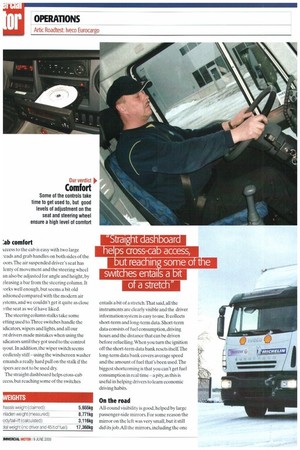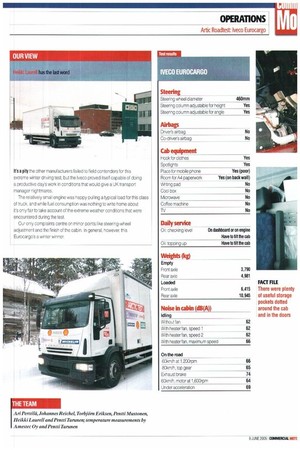COLD
Page 42

Page 44

Page 46

Page 47

If you've noticed an error in this article please click here to report it so we can fix it.
COMFORT wP-7
Climbing Shap in February is a stroll in the park compared with the conditions endured by operators in Finland, as we discovered when we joined the 16th annual Arctic Truck Test — a contest that pushes delivery trucks to their limits.
The aim of the test was to determine which truck would be the top arctic survivor from a group of 18-tonne delivery trucks. All the importers that are active in the Finnish market were invited to supply normal height 4x2 chassis with engines rated at 230-280hp and cabs extended by 180-400mm.
We expected to see trucks with front and rear air suspension but were ready to tackle contenders with air suspension only at the rear. Automated gearboxes were allowed.
We were looking for trucks with typical Finnish bodywork: that is a box length of between 7.70-8.50m with an internal ceiling of 2.40m and an overall height of 2.55m. Importers were also asked to equip their vehicles with tail-lifts rated at more than 1,000kg and cab-roof air deflectors.
That was the plan, at least. In the event, one contender after another was knocked out of the running, until finally we were left with only one test truck, an Iveco Eurocargo 180E28.
Product profile The Eurocargo featured four-bag rear air suspension with steel up front. The 295/ 80R22.5 Michelin tyres (KFN at the front and XDN GRIP at the rear) gave good traction in general, although the fronts would have benefited from better skid resistance.
The common-rail 5.9-litre Iveco was rated at 275hp and produced 930Nm of torque at 1,250-2,100rpm.This engine is said to be ready for Euro-4 with a little tweaking. In any case, it was well up to the job of propelling the Iveco at an all-up weight of 17,360kg (including a driver and 45 litres of fuel).
Drive was handled by an Iveco 2895.9 double-H box that gave us 9+1 gears. Shifting was precise, if heavy, particularly until the oil had warmed up. :ab comfort ccess to the cab is easy with two large Tads and grab handles on both sides of the oors.The air suspended driver's seat has lenty of movement and the steering wheel an also be adjusted for angle and height, by ..leasing a bar from the steering column. It rorks well enough, but seems a bit old ishioned compared with the modern air ystems, and we couldn't get it quite as close ) the seat as we'd have liked.
The steering column stalks take some etting used to. Three switches handle the idicators, wipers and lights, and all our .!st drivers made mistakes when using the idicators until they got used to the control iyout.ln addition, the wiper switch seems eedlessly stiff— using the windscreen washer emands a really hard pull on the stalk if the iipers are not to be used dry.
The straight dashboard helps cross-cab ccess, but reaching some of the switches entails a bit of a stretch. That said, all the instruments are clearly visible and the driver information system is easy to use. It collects short-term and long-term data. Short-term data consists of fuel consumption, driving hours and the distance that can be driven before refuelling. When you turn the ignition off the short-term data bank resets itself.The long-term data bank covers average speed and the amount of fuel that's been used.The biggest shortcoming is that you can't get fuel consumption in real time — a pity, as this is useful in helping drivers to learn economic driving habits.
On the road All-round visibility is good, helped by large passenger-side mirrors. For some reason the mirror on the left was very small, but it still did its job. All the mirrors, including the one xi top of the right-hand door are electrically )owerecl. When driving in wet weather the eft-hand mirror gets dirty very quickly, and )ut on the road the mirrors on the right /ibrate a lot The Iveco handled well, both on the road ind during a handling test at Pudasjarvi firport, but the steering was insensitive, !specially on icy roads where it sometimes elt like the truck wasn't fully under the lriver's control.
By way of contrast the irakes (discs on both axles) lip vere good, even on ice.
t's a pity the same :ouldn't be said of the :xhaust brake, which had to discernable effect. The average fuel :onsumption over the ,605km test route was 9.8mpg 28.81it/100km).The urban section irought it down to 8.7mpg (32.51it/100km), nit out on the open road it rose to 10.2mpg 27.81it/100km). Although these figures are ather worse than those of similar trucks ve've driven, this was rather an unusual test oute. We were driving in temperatures anging from zero to -15°C, some of the time iver rough terrain, and battling against trong headwinds
Winter features
Surprisingly starting a driving shift with the thermometer showing a brisk -15°C would be no problem in this Eurocargo. The cab was filled with warm air soon after starting the engine, and after no more than four minutes at tickover we were ready to hit the road.
With the cab heater adjusted to maximum, we measured the temperature near the driver's feet and head after 30 minutes. Oddly enough there was a stream of warm air to the
insensitive
driver's left foot with cold air directed at his right side:That said, after half an hour's driving the cab was warm enough for us to take our coats off, although the temperature in the cab dropped very rapidly after killing the engine due to the large windows.
We scraped the ice from the windows before we started, and they stayed clear for most of the test.The only difficulty came when it began to rain while the thermometer was reading -8°C (this puzzled us too). forcing us to stop several times to shift ice from the windscreen and wipers. •
OUR VIEW
It's a pity the other manufacturers failed to field contenders for this extreme winter driving test, but the Iveco proved itself capable of doing a productive day's work in conditions that would give a UK transport manager nightmares.
The relatively small engine was happy pulling atypical load for this class of truck, and while fuel consumption was nothing to write home about it's only fair to take account of the extreme weather conditions that were encountered during the test.
Our only complaints centre on minor points like steering-wheel adjustment and the finish of the cabin. In general, however, this Eurocargo's a winter winner.
lAri Pertiiiii, Johannes Reiehel, Torbforn Eriksen, Penn? Mustonen, Heikki Laurell and Penni Turunen; temperature measurements by Amestee Oy and Pentti Turunen THE TEAM






































































































































































































